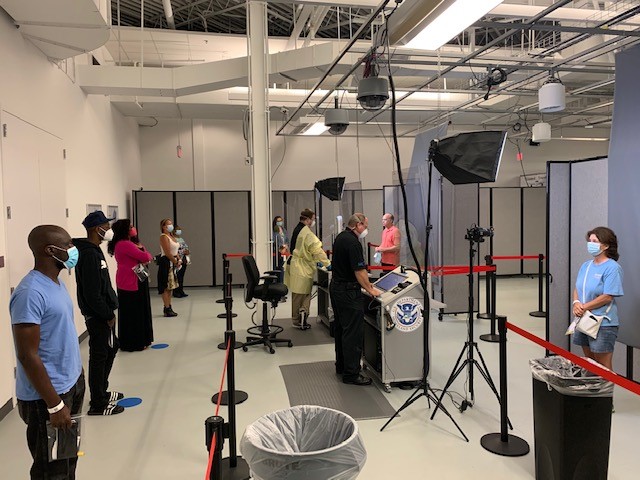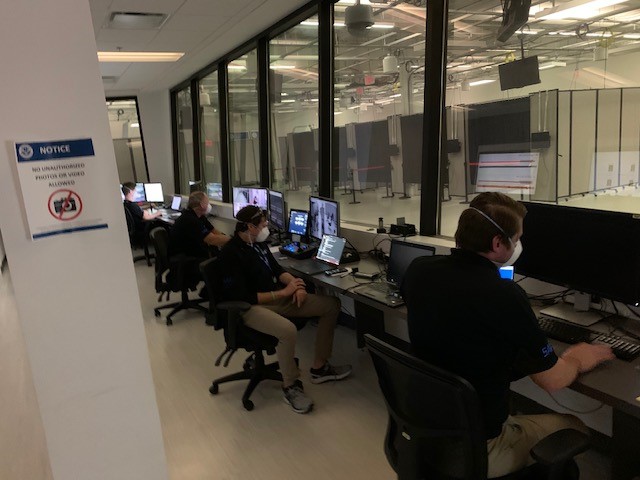
Face masks have become a way of life due to the COVID-19 pandemic. We now wear them nearly everywhere we go—at grocery stores, on public transportation, in schools, at work—any situation that requires us to be around others. But what about at places that require a higher level of security, like airports? One of the challenges the Department of Homeland Security (DHS) Science and Technology Directorate (S&T) is now working to address is how to verify someone’s identity while maintaining overall safety.
Earlier this year, S&T collaborated with the National Institute of Standards and Technology (NIST) on a report that showed that digital masking of face images can compromise the performance of facial recognition algorithms. However, it’s not as bad as one would think. NIST found that the most accurate algorithms recognize people with digitally-applied face masks with accuracy around where it was 2-3 years ago with non-masked photos. This showed that officials could potentially get many travelers through the process without compromising security as well as help keep people safe from infectious diseases like COVID-19. NIST researchers are continuing to collaborate with DHS and are interested in cross-checking previous results with S&T’s work on images collected from volunteers wearing real masks.
During its third annual Biometric Technology Rally, held over three weeks in late September and early October, S&T evaluated the ability of acquisition systems and matching algorithms to reliably collect and/or match images of individuals wearing a diverse array of face masks. Previous Biometric Rallies showed that biometric systems can excel at rapidly processing high volumes of travelers using face recognition. This year’s rally focused on the ability of such systems to detect and recognize travelers without asking them to remove their masks, thereby reducing the risk for both the public and DHS frontline workers.
“In many cases, photo IDs are the best or only way we currently have to verify our identity. Current processes and technologies generally require the face visible. Asking travelers to temporarily remove their mask and put it back on is not an ideal solution,” said Arun Vemury, director of S&T’s Biometric and Identity Technology Center.
 The in-person rally, held at the Maryland Test Facility (MdTF), included 10 days of human testing during which six face and/or iris acquisition systems and 13 matching algorithms were tested with help from 582 diverse test volunteers representing 60 countries. The acquisition systems were evaluated based on their ability to reliably take images of each volunteer with and without masks, volunteer processing time, and overall volunteer satisfaction. Next, the matching algorithms will soon be evaluated based on their ability to accurately identify each volunteer whether or not they are wearing a mask using images from each acquisition system. Researchers from S&T and NIST continue to collaborate to cross-check results between NIST image-based tests and S&T system tests involving real volunteers, masks, and specialized cameras and matching algorithms.
The in-person rally, held at the Maryland Test Facility (MdTF), included 10 days of human testing during which six face and/or iris acquisition systems and 13 matching algorithms were tested with help from 582 diverse test volunteers representing 60 countries. The acquisition systems were evaluated based on their ability to reliably take images of each volunteer with and without masks, volunteer processing time, and overall volunteer satisfaction. Next, the matching algorithms will soon be evaluated based on their ability to accurately identify each volunteer whether or not they are wearing a mask using images from each acquisition system. Researchers from S&T and NIST continue to collaborate to cross-check results between NIST image-based tests and S&T system tests involving real volunteers, masks, and specialized cameras and matching algorithms.
“Technology developers have been working to adapt to the new circumstances and are developing some sophisticated and relatively effective approaches,” said Vemury. “Through careful selection of camera systems and matching systems, it appears possible to verify most people’s identity without requiring them to remove their mask. This isn’t a perfect 100% solution, but it may reduce risks for many travelers, as well as the frontline staff working in airports, who no longer have to ask travelers to remove masks.”
Results from the 2020 Biometric Technology Rally will be published on the MdTF website by the end of the year.

